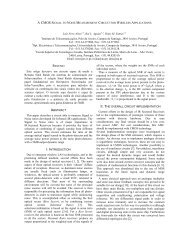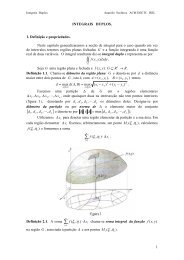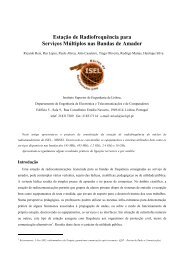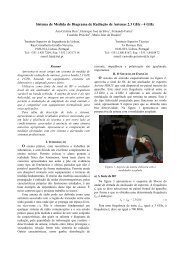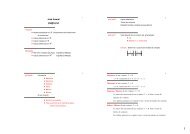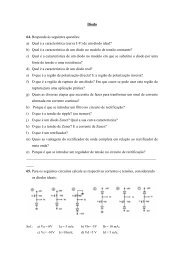NON-ADDICTIVE SAMPLE BASED FACTS - Deetc
NON-ADDICTIVE SAMPLE BASED FACTS - Deetc
NON-ADDICTIVE SAMPLE BASED FACTS - Deetc
Create successful ePaper yourself
Turn your PDF publications into a flip-book with our unique Google optimized e-Paper software.
code to implement one of the report. In the particular<br />
case, the query execution display the rating, for the<br />
main targets, by time periods, for one specific channel.<br />
WITH MEMBER Measures . TargetTotal as<br />
’ LookupCube (" ContactTarget ",<br />
"( Measures . weight ,"+ membertostr (<br />
Target . currentmember )+")") ’<br />
MEMBER Measures . rat as<br />
’ Measures . weight / Measures . TargetTotal<br />
/ Measures . num_min ’<br />
, FORMAT_STRING =’ Percent ’<br />
SELECT { Target . currentmember } ON COLUMNS ,<br />
time . Period . Members ON ROWS<br />
FROM AudienceTarget<br />
WHERE ( Measures .rat , Program . Canal .[2])<br />
Listing 1: The rating for the main targets by time periods<br />
for channel 2 using the target aggregate<br />
The code is rather simple because each target<br />
weight is pre-calculated in the ContactTarget aggregate.<br />
The LookupCube function lookup the value for<br />
each target querying it. With the absence of this cube,<br />
each target weight is calculate in runtime, looking up<br />
each socio-demographic variable that made up the target.<br />
Not only the execution times rise up, but also the<br />
query’ code.<br />
4 Conclusion<br />
This work presents a dimensional model capable<br />
to address the specificities of quota sample based data.<br />
The goal was twofold; first, to demonstrate that is<br />
possible to address audience analysis requirements,<br />
using non-proprietary repositories and technologies;<br />
second, to present a possible solution to other domains<br />
where data is also quota sample based. In the<br />
audience domain, the data tendencies are corrected by<br />
a daily individual weight, that must be taken into account<br />
if the indicators are meant to be representative<br />
to the entire population, not just the panel’s individuals.<br />
To deal with the audience performance indicators,<br />
mostly non-addictive and quota depended, is necessary<br />
to normalise each one with a reference value, calculated<br />
from the corrective daily weights. The present<br />
solution lay on the creation of an auxiliary contact table<br />
to store daily weights for each possible combination<br />
of socio-demographis values. The authors transform<br />
this way the non-addictive facts into addictive<br />
ones, sacrificing the capability of pre-calculated their<br />
values and store them into a fact table directly. All of<br />
the calculus must be done in runtime. To ensure an<br />
efficient solution, is necessary to create a series of domain<br />
dependant aggregates, with specific dimension<br />
models. The performance indicators test results, using<br />
both proprietary program and generic OLAP tools<br />
with the discussed model, have matched.<br />
Authors think the same methodology is appropriate<br />
to other domains if the data is quota sample based<br />
and the performance indicators values are always relative<br />
to the subset of the sample used in their calculus.<br />
REFERENCES<br />
[1] Yvonne M. M. Bishop, E. F. Fienberg, and P. W. Holland.<br />
Discrete multivariate analysis : theory and practice.<br />
The MIT Press, 1975.<br />
[2] EF Codd, SB Codd, and CT Sally. Providing<br />
OLAP to user-analysis. Technical report,<br />
http://www.arborsoft.com/essbase/wht ppr/coddps.<br />
zip, 1993.<br />
[3] Nuno Datia. Aplicação de técnicas de apoio à decisão<br />
a dados de audimetria. Master’s thesis, Faculdade de<br />
Ciências e Tecnologia - Universidade Nova de Lisboa,<br />
2006.<br />
[4] W. Edwards Deming and Frederick F. Stephan. On a<br />
least squares adjustment of a sampled frequency table<br />
when the expected marginal totals are known. Annals<br />
of Mathematical Statistics, 11(4):427–444, 1940.<br />
[5] C. Imhoff, N. Galemmo, and J.G. Geiger. Mastering<br />
Data Warehouse Design: Relational and Dimensional<br />
Techniques. Wiley, 2003.<br />
[6] WH Inmon. Building the data warehouse. John Wiley<br />
& Sons, Inc. New York, NY, USA, 2005.<br />
[7] N. Jukic, B. Jukic, and M. Malliaris. Online Analytical<br />
Processing (OLAP) for Decision Support. In<br />
Handbook on Decision Support Systems. Springer,<br />
2008.<br />
[8] R. Kimball, L. Reeves, M. Ross, and W. Thornthwaite.<br />
The Data Warehouse Lifecycle Toolkit. Wiley, 1998.<br />
[9] R. Kimball and M. Ross. The Data Warehouse Toolkit:<br />
The Complete Guide to Dimensional Modeling. Wiley,<br />
2002.<br />
[10] MediaSoft Kimono. http:// www. kubik. it/<br />
kimono_ en. html , last acessed on May 2008.<br />
[11] Sql Server Analysis Services. http://<br />
technet. microsoft. com/ pt-br/ sqlserver/<br />
bb671220(en-us). aspx , last acessed on May 2008.<br />
[12] Sql Server Data TRansformations Services. http://<br />
www. microsoft. com/ technet/ prodtechnol/ sql/<br />
2000/ deploy/ dtssql2k. mspx , last acessed on May<br />
2008.<br />
[13] Markdata Telereport. http:// www. markdata. net/<br />
v2/ , last acessed on May 2008.<br />
[14] Rene Weber. Methods to Forecast Television Viewing<br />
Patterns for Target Audiences. In Communication Research<br />
in Europe and Abroad –Challenges of the First<br />
Decade, 2003.




